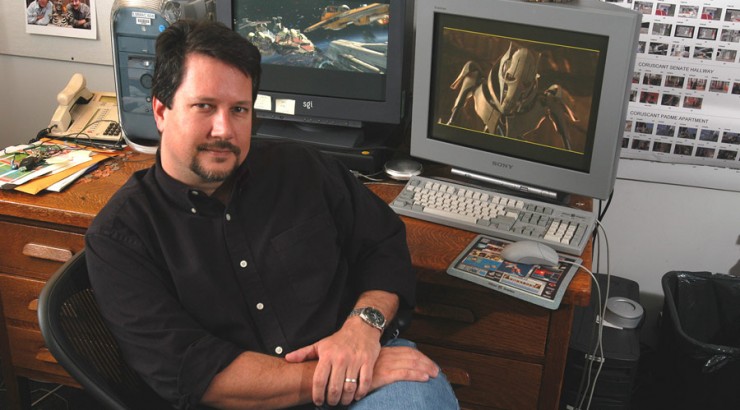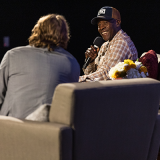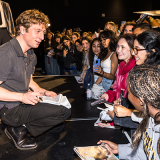
Special Guest John Knoll Connects VFX Past to Present
December 5, 2013
Professor Bill Kroyer’s History and Aesthetics of Digital Arts class enjoyed an amazing treat last night, as they heard from one of the founding fathers of modern visual effects: John Knoll.
The class began, as always, with 3 brief student presentations, on their favorite aspects of their favorite digital film:
- Lilo & Stitch: for representing offbeat personalities within a “for kids” genre
- Inception: Ironically, the most impressive effects were not computer generated! The iconic exploding corner cafe, rotating hallway, and ‘glittery’ effects in the dreamworld are all in-camera effects; no computer graphics necessary.
- The Bear & The Hare: A truly astonishing combination of flat and 3D-printed images combine to give the short its unique look
And with that, the stage was set. Mr. Knoll was on!
The bulk of his presentation was an in-depth look at his career, with a focus on the impressive array of mediums he worked in.
In his words, he wanted to tell us his “origin story.” His early life, his family, his hobbies. John stressed again and again that it was his activity in so many different mediums that formed the true beginning of his career.
Who knew that one of the masters of modern VFX began by building scale models? Although the techniques he began in, are leagues apart from his current work in the digital sphere, his career mimics the transition the industry itself took.
Not surprisingly, he loved movies, and found himself drawn to the created worlds of science fiction classics. Of course, the limitations of technology at the time made it either difficult or expensive to transform out world into another.
Interestingly, he also cited the trade magazines of the time, as essential resources for developing the community around what would become VFX. That, of course, is one area the students of today have a significant advantage in: the digital transformation which birthed digital effects, eventually birthed the internet.
We continued on through his life at USC, across his alternatingly hilarious and eye-catching student films, and into his early career. Persistence, and resourcefulness, are the keys he identified for what we think of “indie” success. In over a dozen stories, he described interesting and simple visual ‘tricks’ he employed across films, shorts, commercials, graphics, magazines, etc. to create startling visual effects without computers.
And as we progressed through the decades of his career, one theme emerged: that although the tools have changed beyond recognition, the spirit of the early stop-animation masters like Ray Harryhausen, who worked only with their hands, is still alive and well, even if we tend to think first of the computer in computer-generated VFX.
Students looking to tread in his footsteps will take comfort in his central message, that persistence, dedication, and creativity will always lead you in the right direction, if you’re willing to look for the opportunities you can find — and create. I love this story (paraphrased):
Just after Star Wars, and the hooplah and excitement it caused, I got a very special taste of the industry: a long-shot phone call to ILM, the only shop in town at the time, got me a personal tour of the facilities with a very friendly engineer. He let me in, and showed me all around, their studios, and what they were working on. That’s one thing — you probably couldn’t do that today. But just that little taste of the magic-makers at work, and I was hooked.
And, of course, much to the audience’s delight, the little taste he described is what they get to work on, every day.
With that, I leave you with one of my favorite samples of his (early!) work, the Meow Mix “Close Enoucnters of the 3rd Kind” commercial:

